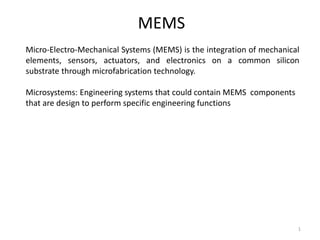
Micromachining bulk
- 1. MEMS Micro-Electro-Mechanical Systems (MEMS) is the integration of mechanical elements, sensors, actuators, and electronics on a common silicon substrate through microfabrication technology. Microsystems: Engineering systems that could contain MEMS components that are design to perform specific engineering functions 1
- 2. Scale of MEMS & Microsystems 2
- 3. Micromachining Silicon micromachining is the process of fashioning microscopic mechanical parts out of a silicon substrate or, indeed, on top of a silicon substrate. It is used to fabricate a variety of mechanical microstructures including beams, diaphragms, grooves, orifices, springs, gears, suspensions, and a great diversity of other complex mechanical structures. These mechanical structures have been used successfully to realise a wide range of microsensors and microactuators. Silicon micromachining comprises two technologies: •Bulk micromachining •surface micromachining. 3
- 4. Bulk micromachining This type of micromachining is used to realise micromechanical structures within the bulk of a single-crystal silicon (SCS) wafer by selectively removing the wafer material. Etching is the key technological step for bulk micromachining. The etch process employed in bulk micromachining comprises one or several of the following techniques: 1.Wet isotropic etching 2.Wet anisotropic etching 3. Plasma isotropic etching 4. Reactive ion etching (RIE) 5. Etch-stop techniques In addition to an etch process, bulk micromachining often utilises wafer bonding and buried oxide-layer technologies. 4
- 5. ISOTROPIC AND ORIENTATION-DEPENDENT WET ETCHING Wet chemical etching is widely used in semiconductor processing. It is used for lapping and polishing to give an optically flat and damage-free surface and to remove contamination that results from wafer handling and storing. Most importantly, it is used in the fabrication of discrete devices and integrated circuits (ICs) of relatively large dimensions to delineate patterns and to open windows in insulating materials. most of the wet-etching processes are isotropic, that is, unaffected by crystallographic orientation. However, some wet etchants are orientation-dependent, that is, they have the property of dissolving a given crystal plane of a semiconductor much faster than other planes 5
- 6. Anisotropic etching characteristics of different wet etchants for single-crystalline silicon 6
- 7. ISOTROPIC AND ORIENTATION-DEPENDENT WET ETCHING A commonly used orientation-dependent etch for silicon consists of a mixture of potassium hydroxide (KOH) in water and isopropyl alcohol. The etch-rate is about 2.1 um/min for the (110) plane, 1.4 um/min for the (100) plane, and only 0.003 um/min for the (111) plane at 80 °C; therefore, the ratio of the etch rates for the (100) and (110) planes to the (111) plane are very high at 400:1 and 600:1, respectively. 7